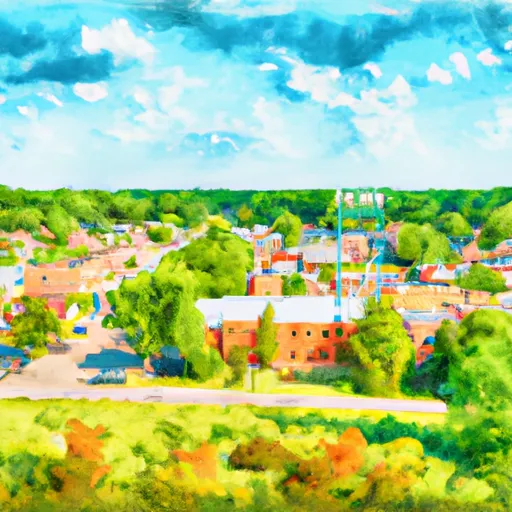-
 Snoflo Premium
Snoflo Premium
Get unlimited access to all our content
With no Ad interruptions! - Start Your Free Trial Login with existing account
Ravenna
Eden Index
Climate
7.4
•
Recreation
4.2
•
Community
2.7
•
Safeguard
5.1/10

Ravenna is a small community in Muskegon County, Michigan, with a population of approximately 1,200 residents. The climate in Ravenna is characterized by cold winters and mild summers. Average temperatures range from the high 20s to mid-30s °F (-2 to 2 °C) in winter and from the mid-60s to low 80s °F (18 to 28 °C) in summer. The region experiences moderate precipitation throughout the year.
Ravenna is surrounded by natural beauty and outdoor recreation opportunities. The area is known for its numerous lakes and rivers, including the Muskegon River and Crockery Creek. These water bodies provide excellent opportunities for fishing, boating, and kayaking. Anglers can find a variety of fish species, including trout, salmon, and bass.
Additionally, Ravenna is situated near several state parks and recreational areas, such as the P.J. Hoffmaster State Park and the Muskegon State Park. These parks offer scenic trails for hiking and biking, as well as picnicking and camping facilities. Outdoor enthusiasts can also enjoy birdwatching, wildlife observation, and hunting in the surrounding forests.
In summary, Ravenna, Michigan, boasts a refreshing climate, abundant hydrology constituents, and a wealth of outdoor recreation opportunities for those seeking to immerse themselves in nature.
What is the Eden Index?
The Snoflo Eden Index serves as a comprehensive rating system for regions, evaluating their desirability through a holistic assessment of climate health, outdoor recreation opportunities, and natural disaster risk, acknowledging the profound impact of these factors on livability and well-being.
Climate Health Indicator (CHI): 7.4
Ravenna receives approximately
939mm of rain per year,
with humidity levels near 81%
and air temperatures averaging around
9°C.
Ravenna has a plant hardyness factor of
6, meaning
plants and agriculture in this region thrive during a short period during spring and early summer. Most
plants will die off during the colder winter months.
By considering the ideal temperature range, reliable water supplies, clean air, and stable seasonal rain or snowpacks, the Climate Health Indicator (CHI) underscores the significance of a healthy climate as the foundation for quality living.
A healthy climate is paramount for ensuring a high quality of life and livability in a region, fostering both physical well-being and environmental harmony. This can be characterized by ideal temperatures, reliable access to water supplies, clean air, and consistent seasonal rain or snowpacks.
Weather Forecast
Streamflow Conditions
Southeastern Lake Michigan
Area Rivers
Southeastern Lake Michigan
Snowpack Depths
Southeastern Lake Michigan
Reservoir Storage Capacity
Southeastern Lake Michigan
Groundwater Levels
Recreational Opportunity Index (ROI): 4.2
The Recreational Opportunity Index (ROI) recognizes the value of outdoor recreational options, such as parks, hiking trails, camping sites, and fishing spots, while acknowledging that climate plays a pivotal role in ensuring the comfort and consistency of these experiences.
Access to outdoor recreational opportunities, encompassing activities such as parks, hiking, camping, and fishing, is crucial for overall well-being, and the climate plays a pivotal role in enabling and enhancing these experiences, ensuring that individuals can engage in nature-based activities comfortably and consistently.
Camping Areas
| Campground | Campsites | Reservations | Toilets | Showers | Elevation |
|---|---|---|---|---|---|
| Mississinewa Lake - Miami Recreation Area | 430 | 764 ft | |||
| Wabash City RV Park | None | 661 ft | |||
| Minnie Pond | 18 | 850 ft | |||
| Kosciusko County Fairgrounds | 40 | 821 ft | |||
| Elkhart County Fairgrounds | 222 | 803 ft | |||
| Fremont Lake City Park | None | 747 ft | |||
| Pines Point | 94 | 717 ft | |||
| Pike Lake County Campground | None | 810 ft | |||
| Ed H. Henning Park | 60 | 700 ft | |||
| White River Campground | 106 | 774 ft |
Nearby Ski Areas
Catastrophe Safeguard Index (CSI):
The Catastrophe Safeguard Index (CSI) recognizes that natural disaster risk, encompassing floods, fires, hurricanes, and tornadoes, can drastically affect safety and the overall appeal of an area.
The level of natural disaster risk in a region significantly affects safety and the overall livability, with climate change amplifying these risks by potentially increasing the frequency and intensity of events like floods, fires, hurricanes, and tornadoes, thereby posing substantial challenges to community resilience and well-being.
Community Resilience Indicator (CRI): 2.7
The Community Resilience Indicator (CRI) recognizes that education, healthcare, and socioeconomics are crucial to the well-being of a region. The CRI acknowledges the profound impact of these elements on residents' overall quality of life. By evaluating educational resources, healthcare accessibility, and economic inclusivity, the index captures the essential aspects that contribute to a thriving community, fostering resident satisfaction, equity, and social cohesion.

